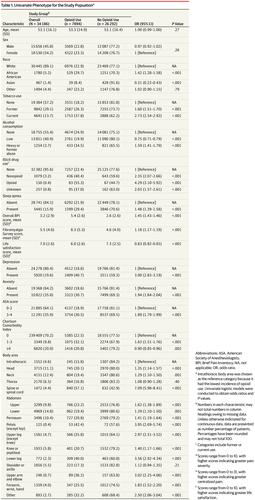当前位置:
X-MOL 学术
›
JAMA Surg.
›
论文详情
Our official English website, www.x-mol.net, welcomes your
feedback! (Note: you will need to create a separate account there.)
Prevalence of Preoperative Opioid Use and Characteristics Associated With Opioid Use Among Patients Presenting for Surgery.
JAMA Surgery ( IF 15.7 ) Pub Date : 2018-10-01 , DOI: 10.1001/jamasurg.2018.2102 Paul E Hilliard 1 , Jennifer Waljee 2, 3 , Stephanie Moser 1 , Lynn Metz 1 , Michael Mathis 1 , Jenna Goesling 1 , David Cron 4 , Daniel J Clauw 1, 5, 6 , Michael Englesbe 2, 3 , Goncalo Abecasis 7 , Chad M Brummett 1, 3
JAMA Surgery ( IF 15.7 ) Pub Date : 2018-10-01 , DOI: 10.1001/jamasurg.2018.2102 Paul E Hilliard 1 , Jennifer Waljee 2, 3 , Stephanie Moser 1 , Lynn Metz 1 , Michael Mathis 1 , Jenna Goesling 1 , David Cron 4 , Daniel J Clauw 1, 5, 6 , Michael Englesbe 2, 3 , Goncalo Abecasis 7 , Chad M Brummett 1, 3
Affiliation

|
Importance
Patterns of preoperative opioid use are not well characterized across different surgical services, and studies in this patient population have lacked important self-reported data of pain and affect.
Objectives
To assess the prevalence of preoperative opioid use and the characteristics of these patients in a broadly representative surgical cohort.
Design, Setting, and Participants
Cross-sectional, observational study of patients undergoing surgery at a tertiary care academic medical center. Data were collected as a part of large prospective institutional research registries from March 1, 2010, through April 30, 2016.
Exposures
Preoperative patient and procedural characteristics, including prospectively assessed self-reported pain and functional measures.
Main Outcomes and Measures
Patient-reported opioid use before surgery.
Results
Of the total 34 186 patients recruited (54.2% women; mean [SD] age, 53.1 [16.1] years), preoperative opioid use was reported in 7894 (23.1%). The most common opioids used were hydrocodone bitartrate (4685 [59.4%]), tramadol hydrochloride (1677 [21.2%]), and oxycodone hydrochloride (1442 [18.3%]). Age of 31 to 40 years (adjusted odds ratio [aOR], 1.26; 95% CI, 1.10-1.45), tobacco use (former use aOR, 1.32 [95% CI, 1.22-1.42]; current use aOR, 1.62 [95% CI, 1.48-1.78]), illicit drug use (aOR, 1.74; 95% CI, 1.16-2.60), higher pain severity (aOR, 1.33; 95% CI, 1.31-1.35), depression (aOR, 1.22; 95% CI, 1.12-1.33), higher Fibromyalgia Survey scores (aOR, 1.06, 95% CI, 1.05-1.07), lower life satisfaction (aOR, 0.95, 95% CI, 0.93-0.96), and more medical comorbidities (American Society of Anesthesiology score aOR, 1.47 [95% CI, 1.37-1.58]; Charlson Comorbidity Index aOR, 1.29 [95% CI, 1.18-1.41]) were all independently associated with preoperative opioid use. Preoperative opioid use was most commonly reported by patients undergoing orthopedic (226 [65.1%]) and neurosurgical spinal (596 [55.1%]) procedures and least common among patients undergoing thoracic procedures (244 [15.7%]). After adjusting for patient characteristics, the patients undergoing lower extremity procedures were most likely to report preoperative opioid use (aOR, 3.61; 95% CI, 2.81-4.64), as well as those undergoing pelvic (excluding hip) (aOR, 3.09; 95% CI, 1.88-5.08), upper extremity (aOR, 3.07; 95% CI, 2.12-4.45), and spinal or spinal cord (aOR, 2.68; 95% CI, 2.15-3.32) procedures, with the group undergoing intrathoracic surgery as the reference group.
Conclusions and Relevance
In this large study of preoperative opioid use that includes patient-reported outcome measures, more than 1 in 4 patients presenting for surgery reported opioid use. These data provide important insights into this complicated patient population that would appear to help guide future preoperative optimization and perioperative opioid-weaning interventions.
中文翻译:

手术患者中术前使用阿片类药物的流行程度以及与阿片类药物使用相关的特征。
术前使用阿片类药物的重要性模式在不同的手术服务中并未得到很好的表征,并且该患者人群的研究缺乏重要的自我报告的疼痛和影响数据。目的在具有广泛代表性的外科手术队列中评估术前使用阿片类药物的患病率以及这些患者的特征。设计,设置和参与者在三级护理学术医学中心对接受手术治疗的患者进行横断面观察研究。数据收集自2010年3月1日至2016年4月30日,是大型前瞻性机构研究注册表的一部分。暴露术前患者和手术特征,包括前瞻性评估的自我报告的疼痛和功能性措施。主要结果和措施手术前患者报告的阿片类药物使用情况。结果在总共招募的34 186名患者中(54.2%为女性;平均[SD]年龄为53.1 [16.1]岁),有7894名患者报告了术前使用阿片类药物(23.1%)。最常用的阿片类药物为酒石酸氢可酮(4685 [59.4%]),盐酸曲马多(1677 [21.2%])和盐酸羟可待酮(1442 [18.3%])。年龄为31至40岁(调整后的优势比[aOR],1.26; 95%CI,1.10-1.45),烟草使用(以前使用aOR,1.32 [95%CI,1.22-1.42];当前使用aOR,1.62 [95] %CI,1.48-1.78]),非法药物使用(aOR,1.74; 95%CI,1.16-2.60),更高的疼痛程度(aOR,1.33; 95%CI,1.31-1.35),抑郁症(aOR,1.22; 95) %CI,1.12-1.33),更高的纤维肌痛调查得分(aOR,1.06,95%CI,1.05-1.07),较低的生活满意度(aOR,0.95,95%CI,0.93-0.96),以及更多的医疗合并症(美国学会,麻醉学评分aOR为1.47 [95%CI,1.37-1.58];Charlson合并症指数aOR为1.29 [95%CI,1.18-1.41]与术前使用阿片类药物独立相关。术前使用阿片类药物的情况最常见于骨科手术患者(226 [65.1%])和神经外科脊柱手术患者(596 [55.1%]),而胸腔手术患者最不常见(244 [15.7%])。在根据患者特征进行调整后,接受下肢手术的患者最有可能报告术前使用阿片类药物(aOR,3.61; 95%CI,2.81-4.64)以及接受骨盆(不包括髋关节)的患者(aOR,3.09; 95)百分比CI,1.88-5.08),上肢(aOR,3.07; 95%CI,2.12-4.45)和脊髓或脊髓(aOR,2.68; 95%CI,2.15-3.32),并且该组患者进行了胸腔内手术作为参考组。结论和相关性在这项包括患者报告的结局指标在内的术前使用阿片类药物的大型研究中,有四分之一的手术患者报告使用了阿片类药物。这些数据为这一复杂的患者群体提供了重要的见解,似乎有助于指导将来的术前优化和围手术期使用阿片类药物断奶的干预措施。
更新日期:2018-10-18
中文翻译:

手术患者中术前使用阿片类药物的流行程度以及与阿片类药物使用相关的特征。
术前使用阿片类药物的重要性模式在不同的手术服务中并未得到很好的表征,并且该患者人群的研究缺乏重要的自我报告的疼痛和影响数据。目的在具有广泛代表性的外科手术队列中评估术前使用阿片类药物的患病率以及这些患者的特征。设计,设置和参与者在三级护理学术医学中心对接受手术治疗的患者进行横断面观察研究。数据收集自2010年3月1日至2016年4月30日,是大型前瞻性机构研究注册表的一部分。暴露术前患者和手术特征,包括前瞻性评估的自我报告的疼痛和功能性措施。主要结果和措施手术前患者报告的阿片类药物使用情况。结果在总共招募的34 186名患者中(54.2%为女性;平均[SD]年龄为53.1 [16.1]岁),有7894名患者报告了术前使用阿片类药物(23.1%)。最常用的阿片类药物为酒石酸氢可酮(4685 [59.4%]),盐酸曲马多(1677 [21.2%])和盐酸羟可待酮(1442 [18.3%])。年龄为31至40岁(调整后的优势比[aOR],1.26; 95%CI,1.10-1.45),烟草使用(以前使用aOR,1.32 [95%CI,1.22-1.42];当前使用aOR,1.62 [95] %CI,1.48-1.78]),非法药物使用(aOR,1.74; 95%CI,1.16-2.60),更高的疼痛程度(aOR,1.33; 95%CI,1.31-1.35),抑郁症(aOR,1.22; 95) %CI,1.12-1.33),更高的纤维肌痛调查得分(aOR,1.06,95%CI,1.05-1.07),较低的生活满意度(aOR,0.95,95%CI,0.93-0.96),以及更多的医疗合并症(美国学会,麻醉学评分aOR为1.47 [95%CI,1.37-1.58];Charlson合并症指数aOR为1.29 [95%CI,1.18-1.41]与术前使用阿片类药物独立相关。术前使用阿片类药物的情况最常见于骨科手术患者(226 [65.1%])和神经外科脊柱手术患者(596 [55.1%]),而胸腔手术患者最不常见(244 [15.7%])。在根据患者特征进行调整后,接受下肢手术的患者最有可能报告术前使用阿片类药物(aOR,3.61; 95%CI,2.81-4.64)以及接受骨盆(不包括髋关节)的患者(aOR,3.09; 95)百分比CI,1.88-5.08),上肢(aOR,3.07; 95%CI,2.12-4.45)和脊髓或脊髓(aOR,2.68; 95%CI,2.15-3.32),并且该组患者进行了胸腔内手术作为参考组。结论和相关性在这项包括患者报告的结局指标在内的术前使用阿片类药物的大型研究中,有四分之一的手术患者报告使用了阿片类药物。这些数据为这一复杂的患者群体提供了重要的见解,似乎有助于指导将来的术前优化和围手术期使用阿片类药物断奶的干预措施。











































 京公网安备 11010802027423号
京公网安备 11010802027423号